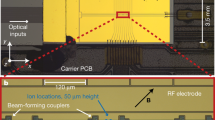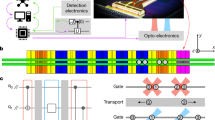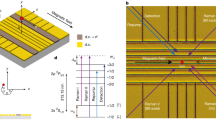Abstract
Quantum computers require the storage of quantum information in a set of two-level systems (called qubits), the processing of this information using quantum gates and a means of final readout1. So far, only a few systems have been identified as potentially viable quantum computer models—accurate quantum control of the coherent evolution is required in order to realize gate operations, while at the same time decoherence must be avoided. Examples include quantum optical systems (such as those utilizing trapped ions2,3,4,5,6,7,8,9 or neutral atoms10,11,12, cavity quantum electrodynamics13,14,15 and nuclear magnetic resonance16,17) and solid state systems (using nuclear spins1,18, quantum dots19 and Josephson junctions20). The most advanced candidates are the quantum optical and nuclear magnetic resonance systems, and we expect that they will allow quantum computing with about ten qubits within the next few years. This is still far from the numbers required for useful applications: for example, the factorization of a 200-digit number requires about 3,500 qubits21, rising to 100,000 if error correction22 is implemented. Scalability of proposed quantum computer architectures to many qubits is thus of central importance. Here we propose a model for an ion trap quantum computer that combines scalability (a feature usually associated with solid state proposals) with the advantages of quantum optical systems (in particular, quantum control and long decoherence times).
This is a preview of subscription content, access via your institution
Access options
Subscribe to this journal
Receive 51 print issues and online access
$199.00 per year
only $3.90 per issue
Buy this article
- Purchase on Springer Link
- Instant access to full article PDF
Prices may be subject to local taxes which are calculated during checkout


Similar content being viewed by others
References
DiVincenzo,D. P. Two-bit gates are universal for quantum computation. Phys. Rev. A 51, 1015–1022 ( 1995).
Cirac,J. I. & Zoller,P. Quantum computations with cold trapped ions. Phys. Rev. Lett. 74, 4091– 4094 (1995).
Monroe,C., Meekhof,D. M., King,B. E., Itano,W. M. & Wineland,D. J. Demonstration of a fundamental quantum logic gate. Phys. Rev. Lett. 75, 4714–4717 (1995).
Poyatos,J. F., Cirac,J. I. & Zoller, P. Quantum gates with hot trapped ions. Phys. Rev. Lett. 81, 1322–1325 (1998).
Steane,A. The ion trap quantum information processor. Appl. Phys. B 64, 623–642 (1997).
Turchette,Q. A. et al. Deterministic entanglement of two trapped ions. Phys. Rev. Lett. 81, 3631–3634 (1998).
Roos,Ch. et al. Quantum state engineering on an optical transition and decoherence in a Paul trap. Pre-print quant-ph/9909038 at 〈xxx.lanl.gov〉 (1999).
Sorensen,A. & Molmer,K. Quantum computation with ions in thermal motion. Phys. Rev. Lett. 82, 1971– 1974 (1999).
Wineland,D. J. et al. Experimental issues in coherent quantum-state manipulation of trapped atomic ions. J. Res. Natl Inst. Stand. Technol. 103, 259 (1998).
Jaksch,D., Briegel,H.-J., Cirac,J. I., Gardiner,C. W. & Zoller,P. Entanglement of atoms via cold controlled collisions. Phys. Rev. Lett. 82, 1975– 1978 (1999).
Brennen,G. K., Caves,C. M., Jessen,P. S. & Deutsch,I. H. Quantum logic gates in optical lattices. Phys. Rev. Lett. 82, 1060–1063 (1999).
Calarco,T. et al. Quantum gates with neutral atoms: Controlling collisional interactions in time dependent traps. Pre-print quant-ph/9905013 at 〈xxx.lanl.gov〉 (1999).
Pellizzari,T., Gardiner,S. A., Cirac,J. I. & Zoller,P. Decoherence, continuous observation, and quantum computing: a cavity QED model. Phys. Rev. Lett. 75, 3788– 3791 (1995).
Turchette,Q. A., Hood,C. J., Lange,W., Mabuchi,H. & Kimble,H. J. Measurement of conditional phase shifts for quantum logic. Phys. Rev. Lett. 75, 4710– 4713 (1995).
Maître,X. et al. Quantum memory with a single photon in a cavity. Phys. Rev. Lett. 79, 769–772 (1997).
Cory,D. G., Fahmy,A. F. & Havel,T. F. Ensemble quantum computing by NMR spectroscopy. Proc. Natl Acad. Sci. USA 94, 1634– 1639 (1997).
Gershenfeld,N. A. & Chuang,I. L. Bulk spin-resonance quantum computation. Science 275, 350– 356 (1997).
Kane,B. E. A silicon-based nuclear spin quantum computer. Nature 393, 133–137 (1998).
Loss,D. & DiVincenzo,D. P. Quantum computation with quantum dots. Phys. Rev. A 57, 120– 126 (1998).
Makhlin,Y. & Schön,G. Josephson-junction qubits with controlled couplings. Nature 398, 305– 307 (1999).
Beckman,D., Chari,A. N., Devabhaktuni, S. & Preskill,J. Efficient networks for quantum factoring. Phys. Rev. A 54, 1034–1063 (1996).
Steane,A. M. Efficient fault-tolerant quantum computing. Pre-print quant-ph/9809054 at 〈xxx.lanl.gov〉 (1998).
DeVoe,R. G. Elliptical ion traps and trap arrays for quantum computation. Phys. Rev. A 58, 910–914 (1998).
Friebel,S., D'Andrea,C., Walz,J., Weitz,M. & Hänsch, T. W. CO2 laser optical lattice with cold rubidium atoms. Phys. Rev. A 57, R20– R23 (1998).
Lloyd,S. Universal quantum simulators. Science 273, 1073–1078 (1996).
Acknowledgements
We thank R. Blatt, D. Leifried and D. Wineland for comments. This work was supported by the Austria Science Foundation, TMR networks from the European Community, and the Institute for Quantum Information GmbH.
Author information
Authors and Affiliations
Corresponding author
Rights and permissions
About this article
Cite this article
Cirac, J., Zoller, P. A scalable quantum computer with ions in an array of microtraps. Nature 404, 579–581 (2000). https://doi.org/10.1038/35007021
Received:
Accepted:
Issue Date:
DOI: https://doi.org/10.1038/35007021
Comments
By submitting a comment you agree to abide by our Terms and Community Guidelines. If you find something abusive or that does not comply with our terms or guidelines please flag it as inappropriate.



